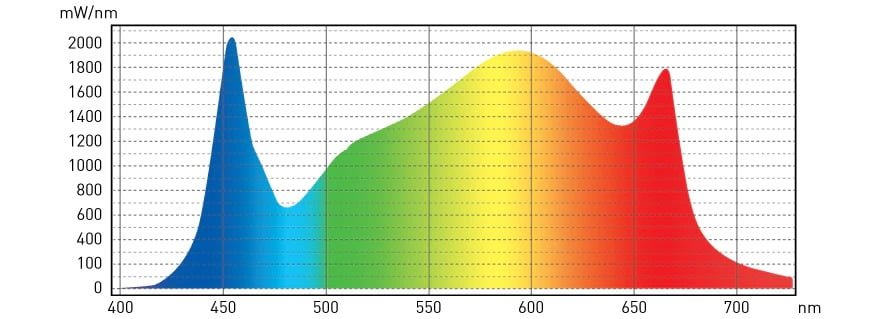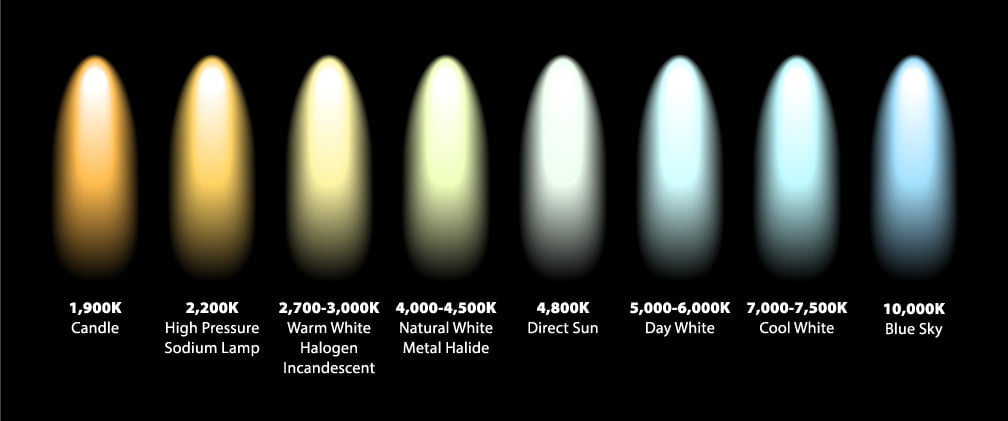Decoding Full Spectrum Lighting in Simple Terms
Table of Contents
Full spectrum lighting is defined as a light source with a color temperature range of 5000K to 6500K. It can also be described as light that covers the electromagnetic spectrum relevant to the beneficial wavelengths for animals and plants. In situations where natural light is unavailable, it’s evident that some form of artificial illumination is required to see our surroundings or perform tasks.
Similarly, plants rely on sunlight for their growth and development. In its absence, they need an artificial light source that replicates the richness of the sun to support their growth. Subsequent sections of this content will delve into various aspects of spectrum lighting. The article will also highlight the pros and cons of its key features.

Is Your Bulb Full Spectrum?
Determining if your bulb emits a full spectrum is crucial. The light scope significantly impacts our well-being and stimulates alertness. But how can we ascertain this? Does the bulb’s classification alone reveal the answer?
LED
LEDs are among the most prevalent and favored light sources. They emit light through digital diodes, producing a warm, natural white glow. Although categorized as a digital light source, LEDs can combine effectively with other sources, such as incandescent or halogen, to optimize illumination.
Halogen
Halogen lighting is often viewed as superior to incandescent lighting, primarily because it emits more of the blue spectrum. The enhanced blue intensity from halogen lights is energizing and highly effective. Nonetheless, they maintain similar lighting advantages as incandescent bulbs.
Fluorescent
Fluorescent lighting exudes a warmth reminiscent of daylight. This suggests a dominance of blue wavelengths over red in its visible light spectrum, resulting in a refreshing effect. Furthermore, fluorescent lights can emit UVB light, promoting vitamin D synthesis.
Incandescent
Incandescent bulbs, often called “analog” lights, can emit a full spectrum of visible light. They also offer beneficial infrared energy. Their scope leans towards red than blue, casting a hue similar to dusk or dawn. The prominence of red wavelengths gives these bulbs a comforting and calming ambiance.

Daylight Bulbs vs. Full Spectrum Bulbs
Spectrum
Daylight bulbs exhibit a warmer color temperature, lacking a full spectrum. In contrast, full-spectrum bulbs lean towards a cooler color temperature.
Wavelength
Daylight bulbs are characterized by a pronounced blue light peak, a feature not observed in full-spectrum bulbs.
Benefits of Full-Spectrum Lighting
Delve into the multitude of perks that come with infusing your home with sunlight, illuminating your space with brightness and warmth.
-
Promotes Better Sleep
Full-spectrum light therapy has been a game-changer in addressing sleep disorders. Studies reveal that it bolsters morning alertness, curtails daytime napping tendencies, amplifies nighttime sleep duration, and intensifies sleep depth, paving the way for a sound, extended sleep.
-
Effortless and Natural
Full-spectrum lights, bulbs, and lamps boast the benefit of being user-friendly, with no downtime post-use. For an enriched sunny ambiance indoors, you can swap out conventional LEDs or integrate full-spectrum light into a therapeutic regimen.
-
Simulates Natural Sunlight Indoors
Direct exposure to sunlight plays a pivotal role in hormone regulation and rejuvenation in our body. The research underlines that disconnecting from such natural cues can adversely affect health. Sub-optimal home lighting can spawn issues like disrupted sleep patterns, weight gain, lethargy, and more. Block Blue Light’s mission is steadfast in refining our contemporary settings with blue light filters, red light therapies, and full-spectrum luminance.
-
Supports Bodily Rhythms
A lack of daylight inside often prompts us to resort to LED illumination. However, detachment from organic light disrupts our body’s rhythm. Embracing full-spectrum lighting allows you to bask in daytime radiance at home, syncing with nature’s rhythm and enhancing overall health and vitality.
-
Minimizes Eye Fatigue
Due to their high flicker rate, traditional fluorescent lights can pose vision challenges. Although imperceptible to many, this rapid fluctuation can strain the eyes. In contrast, with its advanced technology, full-spectrum lighting ensures a swift flicker rate that’s gentle on the eyes.
-
Boosts Mood and Energy
Mirroring sunlight’s natural illumination, full-spectrum lighting can uplift one’s mood and vitality. Natural UV rays in sunlight can invigorate the mind, fostering positivity and buoyancy. This can culminate in heightened work zeal and productivity. It’s an ideal lighting alternative for students, setting a conducive backdrop for learning and reading with minimized eye strain. Prioritizing optimal lighting can fine-tune your visual experience in work and home settings.
-
Improves Color Discrimination
Full-spectrum lighting trumps regular indoor fixtures in offering superior color discernment. Many have found a marked difference in recognizing subtle color variations under these lights, as they render a comprehensive color palette. This becomes essential for professionals in visual-centric roles like graphic designing. The innate UV emissions from some full-spectrum bulbs can brighten materials treated with luminous compounds, making texts sharper and enhancing readability.
Drawbacks of Spectrum Lighting
Spectrum lighting enhances certain items to present them in a more alluring or rejuvenated manner. In simpler terms, it alters a product’s appearance. This specialized lighting can change the look of:
- Meat (to a pinkish-white tint)
- Bread (with a warm, slightly amber glow)
- Fish (with a notably calm, somewhat blue tone)
Thus, using full-spectrum LED lights for these purposes may not be ideal.
Choosing the Right Full-Spectrum Lights
Understanding the merits of full-spectrum lighting for your home is essential, especially when weighing them against standard LED or fluorescent bulbs. Here are some factors to consider when shopping for full-spectrum lights:
Color Rendering Index (CRI)
CRI measures how authentically a light source reproduces colors compared to natural sunlight. The scale ranges from 0 to 100, with a genuine full-spectrum light scoring at least 99. Anything lower suggests the light doesn’t encompass the entire color range. For instance, standard white LEDs are often imbalanced, emitting more blue and less of the warmer hues. They usually score a CRI of 80-90. In contrast, Block Blue Light’s Full Spectrum Bio Light boasts a CRI of over 99, ensuring a balanced color output.

Flicker
Traditional LEDs and fluorescents often emit a subtle flicker, potentially leading to eye discomfort, headaches, and even potential eye damage. Even if not immediately noticeable, these lights can flash hundreds of times in a second. Ensure your full-spectrum light is devoid of flickers for the best and healthiest illumination.
Day-to-Night Feature
While full-spectrum light is excellent during the daytime, it’s less suitable at night. Its blue light content can disrupt our internal clock, hampering melatonin production and sleep. An ideal full-spectrum light should have a feature to shift from the blue spectrum to a calming amber light for nighttime use, ensuring undisturbed rest.
Bio Light: A Benchmark in Lighting
BioLight is a pioneer in biologically attuned lighting, presenting low EMF and zero flicker. Its standout feature is its three distinct modes, catering to different times of the day:
- Full Spectrum Day Mode: Encourages consistent energy and a positive mood all day.
- Mixed Mode: Emulates traditional incandescent lighting by combining spectrum elements, excluding blue and amber.
- Night Mode: Uses pure amber light devoid of blue rays, fostering a conducive sleep environment.
Applications of Full Spectrum Lights
-
Alertness & Stimulation
Different shades of light come with specific wavelengths and energy effects. Our eyes see blue light as a cue to initiate cortisol release and suppress melatonin, the sleep hormone. Consequently, blue light is essential for creating a wakeful effect.
-
Promoting Well-being
It’s essential to note that well-being is subjective and varies from person to person. It’s best to incorporate various light technologies, color temperatures, and the like to make the most of your lighting.
-
SAD Alleviation
One of the primary uses of full-spectrum lighting is to address and ease the symptoms of Seasonal Affective Disorder (SAD). Bright light therapy involves exposure to high-intensity white light akin to sunlight. It stimulates our circadian rhythm and provides a refreshing wake-up effect.
-
Depression Management
Some studies suggest that light therapy can help combat Seasonal Affective Disorder (SAD), a type of depression affected by seasonal shifts. Light therapy, which uses a light box that emits sunlight-like light, impacts sleep and mood-related neurotransmitters, helping reduce SAD symptoms.
-
Treating Sleep Disorders
Light therapy remains a foremost treatment for those suffering from circadian sleep disorders, where the regular sleep-wake cycle is disrupted.
-
Indoor Gardening
Much like their outdoor counterparts, indoor plants flourish under full-spectrum light, which mirrors sunlight. Full-spectrum bulbs are optimal for growing houseplants, orchids, culinary herbs, and seed sowing.
-
Art Color Matching
In the northern hemisphere, an art studio is preferably lit by northern sunlight, perceived as more neutral than its southern counterpart. In cases where north-facing windows are absent, artists turn to full-spectrum lamps. These lamps are also favored by color scientists, paint store personnel, quilters, etc., especially when working with fabrics or yarns in dim light.
-
Aquarium Usage
Full-spectrum lighting not only boosts the growth of aquatic plants but also enhances the health and colors of the fish and tank. While plants are evolutionarily adapted to natural sunlight, full-spectrum bulbs mimic sunlight’s wavelengths, encouraging plant growth. Furthermore, artificial lights can sometimes diminish the vibrant colors of aquatic life; full-spectrum lighting counters this effect. Typically, freshwater aquariums utilize full-spectrum lighting more than marine or coral reef setups.
If you’re aiming for indoor lighting that closely mirrors natural daylight, full-spectrum bulbs are an excellent choice. Alternatively, Natural White LED bulbs, which closely mimic sunlight, are also worth considering.

How to Gauge the Completeness of Light Spectrum
At its essence, full-spectrum light mirrors the spectral qualities of natural sunlight. A light source can only emulate the benefits of full-spectrum lighting if it closely aligns with this spectral resemblance. While measuring this similarity precisely is challenging, general conclusions can be made. So, how can we swiftly determine the spectrum’s completeness and proximity to natural daylight? The answer lies in two main criteria: color temperature and color rendering.
1. Color Temperature
Color temperature reflects the balance between yellow and blue light, indicating the light hue emitted by a source. A higher temperature suggests a bluer light, while a lower one leans more towards yellow.
Traditional incandescent bulbs, with a color temperature around 2700K, don’t capture the full spectrum lighting benefits as they’re too yellow and diverge from natural sunlight. Similarly, LED and fluorescent lights with a “warm white” range of 2700K to 3000K also fall short.
In contrast, natural daylight possesses a color temperature of 6500K. So, for a bulb to truly replicate the hues of natural light, it should align with this 6500K mark.
Still, a 5000K light might be preferable in some cases. While it isn’t an exact match to sunlight, it closely parallels the 6500K spectrum, offering similar benefits.

2. Color Rendering Index
The Color Rendering Index (CRI) offers insights into the quality of a light spectrum and its impact on color perception. Evaluated on a scale, the highest achievable CRI score is 100, identical to the rating of natural daylight.
A light source with a lower CRI can misrepresent colors compared to natural daylight, a discrepancy attributed to its spectral composition. Conversely, a light source boasting a high CRI will display colors almost indistinguishable from the honest day, thanks to its rich and well-rounded spectrum.
Harnessing the Power of Full-Spectrum Lights for Therapy
LED light therapy has emerged as a gentle yet potent tool for skin rejuvenation, delving deep into skin layers without harm. Tracing its roots to the late 20th century, NASA first explored LEDs’ potential to expedite the healing of astronauts’ injuries by promoting cell and tissue growth.
In our modern era, dermatologists and skincare experts routinely employ LED light treatment for various skin issues. They often marry LED therapy with other modalities, including creams, balms, and facial treatments, to optimize outcomes. LED masks have become increasingly available as therapeutic gadgets for those keen on at-home remedies.
Demystifying Full Spectrum Light Therapy: The Mechanism
A typical session of full-spectrum light therapy involves a light therapy box. Here, an individual either sits or stands before a light-emitting box. The essence of this therapy is to mimic the healthful properties of natural sunlight. Engaging with this therapy is as simple as positioning oneself before a light source. While one can keep their eyes open or shut, direct gazing into the light is discouraged. Persistence is vital—immediate results are rare, but with time, users often report enhanced mental health and alleviation of depressive symptoms.
Three primary elements define light therapy:
- Intensity: Often measured in ‘lux,’ it illustrates the light you receive. The recommended power for treating seasonal affective disorder (SAD) is around 10,000 lux, maintained at a 16 to 24-inch distance. Before obtaining a light, a consultation with a healthcare professional is advisable to understand the precise specifications.
- Duration and Timing: The efficacy of light therapy also hinges on its length and when it’s administered. While many find morning sessions most beneficial, it’s best to tailor this based on individual needs and guidance from a healthcare provider. The specific light equipment you’ve acquired will also influence the therapy’s duration—typically determined by its lux level.
A Brief Dive into the Light Therapy Timeline
While contemporary light boxes signify recent innovations in light therapy, the therapeutic essence of light is a tale as old as time.
Ancient Eras and Light Therapy
Sunbathing was revered for its healing prowess from the Assyrians to the Babylonians. The ancient Greek city, Heliopolis, translating to “City of the Sun,” featured healing sanctuaries adorned with colored window shades believed to have therapeutic properties. The inaugural lines of the Hippocratic Oath salute Apollo, the deity of light, underscoring the era’s recognition of sunlight’s healing capabilities.
The Egyptians, historically celebrated for their medical advancements, held the sun in high regard, evident from their worship of Ra, the sun god. Their therapeutic spaces, much like Heliopolis, featured vibrantly tinted window cloths.
The 19th Century and Light Therapy
By 1818, Jean-Etienne Dominique Esquirol from France highlighted the potential of light therapy for mental health. His insights birthed establishments accentuating natural light. Concurrently, sunlight began to be acknowledged for its potential to address skin ailments and tuberculosis.
The 1980s: A Paradigm Shift
Dr. Norman Rosenthal from Washington is pivotal in identifying Seasonal Affective Disorder. His revelations in 1984 spurred the creation of the inaugural light therapy lamps or boxes.
Today’s World
Currently, light therapy stands as the cornerstone for addressing seasonal mood disorders. Modern therapeutic boxes typically range between 2,500 to 10,000 lux, ideal for maximum benefits.

The Importance of Comprehensive Spectrum Light Therapy
There are primarily two critical reasons for the significance of full spectrum lighting:
-
Enhanced True Color Display
How objects’ colors are presented under a light source is called color rendition. Consider a red apple. Even if we use a fluorescent light that’s sunshine white – mirroring the shade of natural daylight – the apple’s appearance under this light would differ from its look under natural sunlight.
This disparity arises from the specific wavelengths that colors reflect. A fluorescent bulb lacks red in its spectrum. As a result, no red light reflects off the apple, causing its vibrancy to diminish.
Using full spectrum lights is crucial for professions that rely heavily on accurate color representation, like visual arts, photography, and graphic design. It ensures that errors in color perception don’t hinder their work quality.
-
Enhanced Health and Biological Advantages
The benefits of full spectrum lighting aren’t restricted to just visual perception. They influence our broader biological responses, influencing how body pigments and hormones such as melanopsin react to varying light wavelengths and strengths. Unrelated to our visual system, these reactions send signals to our body that influence our mood, alertness, and sleep cycles.
It’s not only humans that benefit. Plants, dependent on light, have varied reactions to different light spectra. Some spectra might boost photosynthesis, while others might encourage blooming or fruiting over leafy growth. Though there’s still a lot to uncover in this area, research has consistently shown the negative impacts of lacking natural light exposure on health.
Consistent access to natural light is a challenge for many due to geographical location, workspace design, work timings, or home structure. Full spectrum lighting seeks to bridge this gap. While no artificial light can wholly mimic natural daylight, the efficiency of a whole spectrum source is determined by its closeness to natural light.
Conclusion
The rapid advancements in lighting technologies, including fluorescent and LED bulbs, have expanded the availability of full spectrum illumination options for consumers. Understanding full-spectrum lighting can be challenging since it’s not perceptible to the naked eye. It’s important to note that color temperature (CCT) and color rendering index (CRI) are the standard metrics for lighting. To accurately assess full spectrum lights, rely on these two indicators. Ideally, the light source should have a CRI rating of 95 or above and a color temperature of 6500K.
MyLikeLed produces top-tier LED strips and LED neon flex. We subject all our products to rigorous testing in state-of-the-art laboratories to guarantee unmatched quality. Moreover, we provide customization opportunities for our LED strips and neon flex. For the best LED strips and LED neon flex, contact MyLikeLed today!
FAQs
Unlike regular lighting, full spectrum lights provide a wider range of wavelengths and give a more natural, balanced light, similar to what you’d experience outdoors on a sunny day.
Full spectrum lighting is important because it can improve mood, productivity, and reduce eye strain by providing a more natural and well-rounded light source.
You can use full spectrum lighting in areas where accurate color representation is important, like art studios, reading rooms, offices, and gardens.
Yes, full spectrum lighting is beneficial for plants as it mimics natural sunlight, helping them photosynthesize more effectively, especially in indoor gardens.
Yes, full spectrum lighting can help reduce the effects of Seasonal Affective Disorder (SAD) by simulating the sunlight exposure we lack during darker months.
Absolutely! Full spectrum lighting is great for home environments where you need natural-looking light, whether for living rooms, kitchens, or home offices.

Hi, I’m Xylia Xiong, a sales professional with 14 years of experience in the LED strip light industry. I specialize in providing tailored solutions, leveraging my expertise in LED products and the latest industry trends. Known for effective communication and problem-solving, I’m dedicated to helping lighting manufacturers, importers, and distributors achieve their goals.
Let’s work together to create customized solutions that exceed expectations.
Related Posts

The Best LED Strip Lights You Can Buy Right Now

Comparing WS2811 Vs WS2812B: Key Differences


